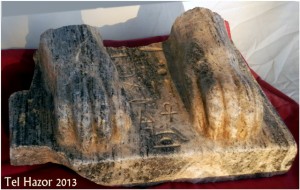World of the Exodus Recreated
 If we use the Biblical timeline, the Moses led Exodus of the Israelites from Egypt happened 480 years before the building of Solomon’s Temple (1 Kings 6:1). Since the latter event happened in the 10th century BCE, that would put the Biblical Exodus circa 1,480 BCE. The majority of Egyptologists say that the Exodus didn’t happen but, if it did, it took place around 1230 BCE. These guys obviously don’t study logic. They don’t understand that you can’t date events that didn’t happen. So let’s stick to the Biblical timeline. 1480 BCE places the Exodus towards the end of the so called “Hykso” period of Egyptian history. The “Hyksos” were “foreign princes” that for some 200 years ruled lower Egypt i.e., the part closer to the Nile Delta. The leaders were called “Hyksos”. The people were called “Amu” or “Amo”. From an Egyptian point of view, the Biblical Joseph, who rose to power in Egypt (Genesis 41:43), would have been considered a “Hykso”. In the Hebrew Bible, the Israelites are called “Amo Israel”, usually translated “His people, Israel” i.e., God’s people. The bottom line is that we have a perfect synchronicity between the so called “Hyksos” and the Biblical Exodus. But not all “Hyksos” were Israelites, and not all Israelites were “Amo”.
If we use the Biblical timeline, the Moses led Exodus of the Israelites from Egypt happened 480 years before the building of Solomon’s Temple (1 Kings 6:1). Since the latter event happened in the 10th century BCE, that would put the Biblical Exodus circa 1,480 BCE. The majority of Egyptologists say that the Exodus didn’t happen but, if it did, it took place around 1230 BCE. These guys obviously don’t study logic. They don’t understand that you can’t date events that didn’t happen. So let’s stick to the Biblical timeline. 1480 BCE places the Exodus towards the end of the so called “Hykso” period of Egyptian history. The “Hyksos” were “foreign princes” that for some 200 years ruled lower Egypt i.e., the part closer to the Nile Delta. The leaders were called “Hyksos”. The people were called “Amu” or “Amo”. From an Egyptian point of view, the Biblical Joseph, who rose to power in Egypt (Genesis 41:43), would have been considered a “Hykso”. In the Hebrew Bible, the Israelites are called “Amo Israel”, usually translated “His people, Israel” i.e., God’s people. The bottom line is that we have a perfect synchronicity between the so called “Hyksos” and the Biblical Exodus. But not all “Hyksos” were Israelites, and not all Israelites were “Amo”.
It seems that during the Israelite period in Egypt, Egypt was divided between true Egyptians in the south and these other people that scholars now call “Hyksos” in the north. Scholars now agree that these northerners were from Canaan, modern day Israel. It seems Moses took advantage of the civil war between the northerners and the southerners and left Egypt with the descendants of the Biblical Jacob and the “Amo” Hyksos, forging them into a nation called Israel (see “The Exodus Decoded”). The “Hyksos” that didn’t join Moses were eventually defeated by the Egyptians under the leadership of Pharaoh Ahmose. The collapse of the “Hyksos” created a power vacuum in Canaan that allowed the Israelites to conquer the land. So, think about it; Canaanites go to Egypt, rule Egypt and Canaan for some 200 years then, as their power collapses, some of them join Moses’ revolution and help reconquer the land of Canaan as Israelites.
But during the 200 years that the “Hyksos” ruled lower Egypt, they took trophies back to Canaan to show who was boss in Egypt. Almost 2,000 years later, the French would bring Egyptian artifacts to Paris and the British to London, as trophies of their power. And now, in northern Israel, the remains of an Egyptian sphinx made by one of the builders of the pyramids has been found. Archaeologists acknowledge that it got there during the Hykso period. But they think it’s a testament to Egyptian power. On the contrary, if it got there during the Hykso period, it’s a testament to Canaanite power! It’s a trophy that victorious Canaanites brought back from Egypt and it’s a monument to a moment in history that created the window of opportunity for the Biblical Exodus to take place.
See: http://www.israelnationalnews.com/News/News.aspx/169753#.Ud2x9-CyTJp

